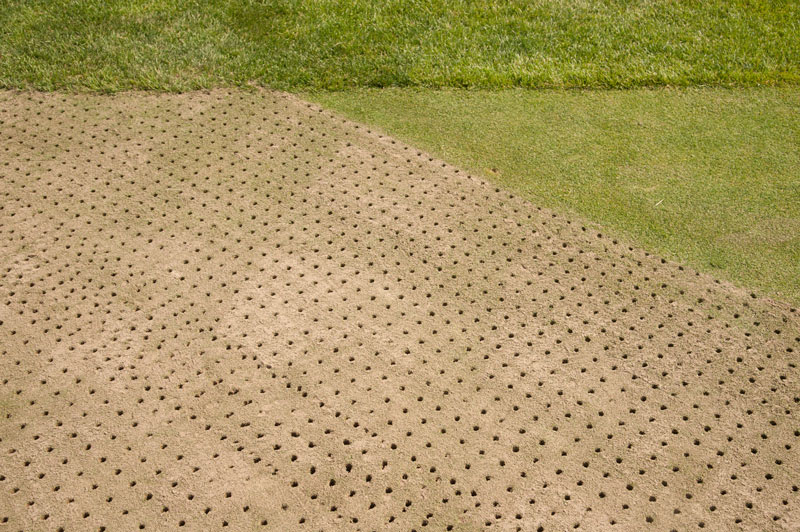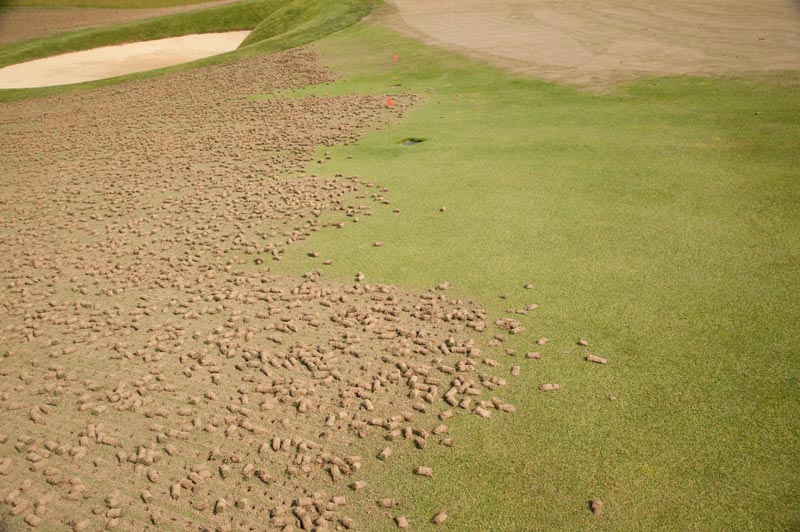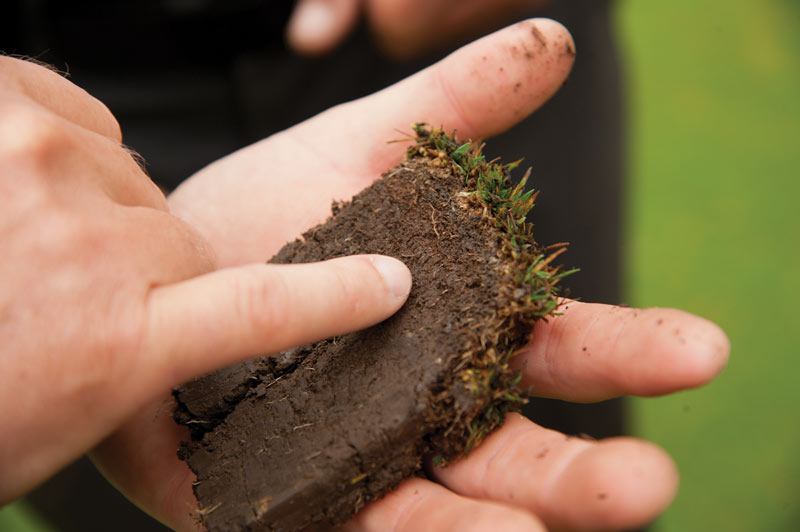
The amount of traffic and a site’s soil type are two of the chief factors that contribute to the development of soil physical problems. Formulating a systematic approach to turf cultivation and fine-tuning it over time will result in healthier turf and more efficient course management. Photos by Montana Pritchard
Editor’s note: The following article first appeared in the August 1990 issue of GCM. Because of its timeless insights for turf managers, we’ve dusted it off and are presenting it anew.
Adverse soil physical conditions are a frequent cause of limited turfgrass growth. Soil compaction, just one cause of poor soil physical properties, is often considered the most important cultural problem on recreational sites.
Alleviation of soil compaction and other physical problems requires several approaches: cultivation, soil modification, drainage, traffic control and careful irrigation. With continual traffic on golf courses, cultivation is the most common means of dealing with adverse soil physical problems.
Although cultivation techniques have been widely used on golf courses, superintendents have found it difficult to develop sound cultivation programs. Fertilization programs, for example, are formulated from a wide base of knowledge about turfgrass fertility needs, soil test results, an understanding of fertilizer carriers, and so forth. From this scientifically based pool of knowledge, a good fertilizer program — setting forth rates, timing of applications and other specific guidelines — can be established. In contrast, cultivation programs have been developed more by trial and error.
In this article, the keys to formulating a sound cultivation program will be discussed. Key steps to developing a good program include the following:
• Identifying the problem(s).
• Selecting the best method(s).
• Determining the desired frequency and timing.
• Applying cultivation at correct soil moisture.
• Evaluating your results.
Identify soil physical problems
Unless the specific, primary (basic) soil physical problem or problems on a site can be identified, several things can occur. First, the best cultivation procedure(s) cannot be chosen, and second, the best overall approach to solving it cannot be determined. Perhaps soil modification or drainage would be a better long-term approach. If cultivation is involved, the frequency of that cultivation is difficult to determine.
Included in identifying the problem is its location within the soil profile (such as a surface compacted layer, a fine-textured soil several feet deep, or a clay lens at 12 inches). Soil physical problems and their location within a soil horizon are not always easy to identify. Symptoms that evolve from the presence of a primary problem are what the grower normally observes, such as a waterlogged soil, standing water, poor aeration, black layer, poor rooting, a hard soil, a droughty area, low infiltration/percolation, and, in some instances, excessive infiltration/percolation. Unfortunately, various symptoms can be caused by several primary problems.
Some suggestions for identification of soil physical problems are:
• Use a probe or shovel to carefully observe the different layers or horizons in the soil profile to a depth of 1½ to 2 feet. Do not ignore even small layers if they differ distinctly in texture from surrounding layers.
• If you think a layer is interfering with water movement, take a cup-cutter-sized core with the layer in the middle portion. Add water to the top (in a small depression) to see whether it will move across the layer.
• When the soil has been thoroughly wetted, such as after a prolonged rain, slowly insert a long, pointed steel probe (pencil-sized diameter) into the soil and note whether any areas of high resistance are present. Carefully observe the layers to see whether roots penetrate them or water perches above them.
• Observe the root growth patterns for any indications of limited rooting deeper in the profile. Conditions that hinder rooting throughout the whole profile and not just a zone in the profile are a surface-compacted layer (either thin or several inches in depth) and an excessively fine-textured soil throughout the profile.
• If you suspect a high water table vs. a drainage barrier that perches a water table, core a hole several feet into the soil and follow the depth of the free water table over a three- to four-day period. A high water table will normally remain relatively static, and if it is a perched water table, the deep core should drain it and cause a rapid lowering of the water.
• Use common sense to determine whether poor contouring is simply channeling water into an area in quantities higher than soil infiltration can remove it, thereby causing an excessively wet area.
• If a sodic problem is anticipated, have a soil test conducted.
• Check with individuals with expertise in soil physical problems, such as a state extension specialist, USGA agronomist or soil conservation personnel.
Proper identification of the primary soil physical problems is not easy. This is one of the main reasons why good cultivation “programs” have not evolved nearly as rapidly as other routine programs used on golf courses. However, considering the potential for expending much labor and money without results when the wrong approach is chosen, good motivation exists for a more logical cultivation approach.
Select the best cultivation method or methods
As stated, cultivation is just one choice for alleviating soil physical problems. The pros and cons must be weighed for cultivation, soil modification, drainage, and other less important measures, such as traffic and irrigation control. Often a combination of approaches is necessary.
Because the focus of this article is cultivation, we will assume that cultivation is the best option in this instance. The next step is to select the best cultivation method or methods to deal with the physical problems on your site.
Editor’s note: View the chart Comparison of different turfgrass cultivation methods that accompanied this article in the August 1990 issue of GCM.
Important questions to answer here are:
• How much surface disruption will occur? For close-cut turf, this is of particular concern. Also, the degree of disruption is important in determining the time of year an operation can be done, the degree of interference with turf use, and how frequently an operation can be used. Moderate to severe disruption of the sod generally means timing the operation only in a period of rapid regrowth for the species and conducting the procedure as infrequently as possible.
• What is the longevity of expected results, and what is the magnitude of improvement desired? If a procedure results in a reasonably long period of alleviating a problem, then a higher degree of injury may be tolerated. Also, soil physical problems are often corrected by removing excessive water or by altering the pore-size distribution and density of the soil. The later aspects cannot be achieved without soil movement and thus greater potential for injury in many cases.
If the superintendent desires a major degree of soil cultivation, then closer tine/blade spacings or deeper penetration or both will be necessary.
• How deep is the problem located in the soil? Different cultivation procedures may vary from 1/4-inch penetration to 16 inches. Unless cultivation blades or tines penetrate the problem zone, little benefit is expected.
• Is soil loosening desired, or is penetration without loosening acceptable? Certain cultivation operations have a high degree of loosening while others do not. Loosening alters the pore-size distribution and density of fine-textured soils to produce macropores for root, water and gas movement. These macropores would be in addition to any pore space created directly by the tine or blade and would be between areas of penetration.
• Do you desire to topdress with sand after cultivation to modify the soil over time, or keep channels open? Topdressing can be applied after any cultivation procedure that does not bring soil to the surface. However, operations that leave larger or deeper holes require considerable sand to fill the holes, and working the sand into holes is not easy.
Disregarding the difficulties of sand application, sand that fills cultivation cavities (whether small or large) will help prolong the beneficial life of the cultivation operation. It is very desirable to have a cavity open to the soil surface to facilitate maximum water infiltration and gas exchange. A cavity created deeper in the soil that becomes closed to the surface does serve as a root channel, but it is much less effective for water and gas exchange than one open to the surface or filled with sand to the surface.
• Do I want soil to be brought to the surface? A grower may wish to bring soil to the surface to remove it from the site as part of a program to partially modify the soil with sand addition. A frequent concern with Verti-Drain operations on golf greens is whether to use hollow tines and bring up a core, remove it and topdress with sand, or to use solid tines and topdress.
In this case, the “ideal” from a soil physics standpoint would be to use hollow tines to reduce side and bottom compaction around the tine. However, the “practical” belief of this author is that the relatively wide tine spacings and loosening tine action minimize these potential problems. This would not be true for hollow vs. solid coring tines where spacings are at 2 inches and tine operation is vertical without appreciable loosening of the soil.
Sometimes growers want soil to be brought to the surface for the additional benefit of a topdressing. This is a factor to consider, especially on fairways.

• Will localized compacted zones occur somewhere in the soil as a result of using a procedure? The occurrence of a compacted zone immediately beneath 3-inch coring tines — both hollow and solid — has been observed in the field and demonstrated in research situations. A few primary factors influence the development of such layers: Closer tine spacings will result in more rapid formation; soils high in clay and silt are more prone to formation of such zones; and more frequent cultivation, especially on a moist soil, favors compacted zone development.
Any implement that is pushed into the soil will cause some compaction — the important issue is whether more compaction is alleviated than formed. For example, core aeration at 2-inch spacings with 3-inch tines is useful in correcting a compacted surface zone. At the same time, it may contribute to development of a compacted zone at 3 to 4 inches in the profile over a period of time. Periodic cultivation with a procedure that penetrates deeper will correct the deep zone. Once every two or three years would be sufficient on most sites to destroy any deep zone of compaction created by core aeration.
• Other practical considerations when developing a cultivation program include: weight of the equipment on golf greens, cost of purchasing equipment or leasing, availability of equipment for leasing, and speed of operation.
Assuming a clear understanding of the problems present on a site, a cultivation program can be formulated to correct the situation. This generally means that several different procedures often must be used, and when several methods are used, the timing and frequency of each procedure will differ.
For example, core aerification may be conducted in spring and fall on a golf green; pin spiking or small solid-tine coring in summer on a biweekly basis; and Verti-Drain or drill aerification once every two or three years. Each procedure is selected to deal with a specific problem, and the superintendent must weigh the pros and cons of different options and select the best methods for his or her site.
Determine the desired frequency and timing of cultivation
A proposed program should be developed on paper for each site. Frequency of an operation depends on the severity of a problem and persistence of a problem, such as surface soil compaction from normal vehicle and foot traffic. In the case of topsoil that has very high clay content, deep cultivation several times per year would be beneficial for one to two years, followed by a less frequent program of deep cultivation. The same soil, however, would be prone to continual surface compaction and may require core aeration two to three times per year every year.
Timing of cultivation is controlled mainly by the degree of injury that occurs and whether play is disrupted. Operations that cause moderate to severe turf injury should, ideally, be timed when the turf has an opportunity to rapidly heal. For cool-season species, this would be early to late spring and early to mid-autumn. For warm-season grasses, summer is best.
Editor’s note: Read more about timing considerations for turfgrass cultivation in Timing golf course aerification.
When a cultivation operation is performed that causes initial deterioration in turfgrass quality, golf course superintendents have traditionally applied supplemental nitrogen fertilization before or immediately after the procedure to stimulate recovery. Additional irrigation is also used. Research by B.J. Johnson and R.N. Carrow on Tifway bermudagrass demonstrated a long-term decline in turf quality after core aeration, even under a good lawn care program, when supplemental nitrogen and irrigation were not used.
Other factors that influence cultivation timing are:
• Condition of the turf at the time of cultivation.
• Whether any unusual environmental or pest stresses are present.
• The potential for weed seed exposure, especially Poa annua.
• Whether the pre-emergence herbicide barrier to control annual grasses may be disrupted. Researchers at Michigan State and Georgia have demonstrated this is not a concern in most situations.
• The availability of labor.
• Whether soil moisture is suitable.
Apply cultivation at the correct soil moisture
Different cultivation methods are most effective at a particular soil moisture level at the time of application. If soil moisture is outside this range, effectiveness declines.
Methods that have a loosening action on the soil are more effective if the soil is somewhat drier than field capacity. Field capacity would be the soil moisture at one day after a good irrigation or rainfall event on a fine-textured soil. “Somewhat drier” would be two to four days after irrigation or rainfall.
If the soil becomes too dry, the implement will not be able to penetrate and will lose its effectiveness. In contrast, on excessively moist soils, little loosening action will occur.
For operations that penetrate the soil but have minimal loosening action, a soil moisture near field capacity would be best. Any cultivation should be avoided at soil moisture above (wetter than) field capacity to avoid destruction of the soil structure.
Evaluate your results
The benefits of cultivation are often difficult to evaluate. You should be able to observe improved infiltration/percolation, better rooting, increased shoot growth, or loosening of the soil. Thus, the grower should see fewer of the symptoms that represent clues to the presence of soil physical problems. The same procedures recommended for identifying the primary problems on a site are beneficial for identifying results. Careful observation of the soil profile is particularly beneficial. Sometimes an untreated area can be left for comparison.

While evaluation of cultivation results is difficult, it is well worth the effort to adjust your program over time. Certainly this is one area where the experience of a superintendent and observation over time are essential.
In conclusion, cultivation programs evolve by long-term experience on a particular site (i.e., trial and error); using what someone else has found effective; using the “latest” device with hopes it will be the right operation; or by a careful analysis of the problems, evaluation of different options, and correct use of various procedures.
The main reasons that better cultivation programs have not evolved are: 1) difficulty in determining the primary soil physical problem(s) present on a site, and 2) a lack of specific, comparative data on how each cultivation method influences soil physical conditions and turfgrass growth.
Historically, growers have had to rely on empirical observation to determine the relative effectiveness of different techniques. In recent years, research projects supported by the USGA Green Section at Michigan State University and the University of Georgia have greatly increased our knowledge about various methods. Much of this information will be published over the next year.
Because soil physical problems exist on almost all golf courses and cultivation is a main tool to alleviate these problems, the development of a sound cultivation program is important. Using the same logical and scientific approach used for other cultural practices to formulate a cultivation program will result in improved and more efficient cultivation and better turf.
Robert N. Carrow is a professor in the Department of Crop and Soil Sciences at the University of Georgia.